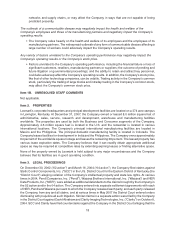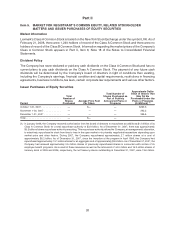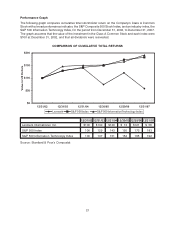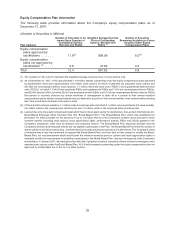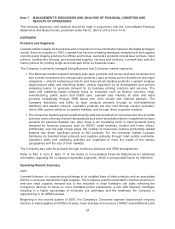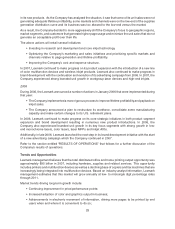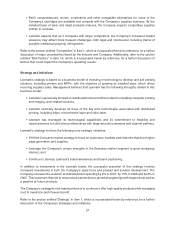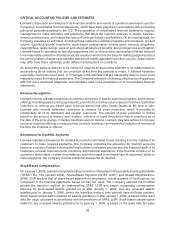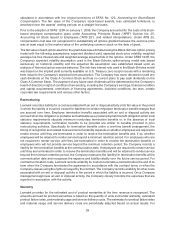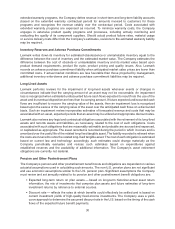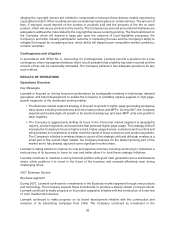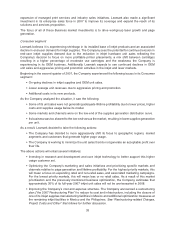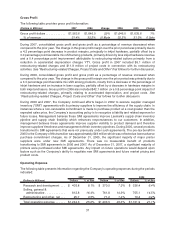Lexmark 2007 Annual Report Download - page 34
Download and view the complete annual report
Please find page 34 of the 2007 Lexmark annual report below. You can navigate through the pages in the report by either clicking on the pages listed below, or by using the keyword search tool below to find specific information within the annual report.CRITICAL ACCOUNTING POLICIES AND ESTIMATES
Lexmark’s discussion and analysis of its financial condition and results of operations are based upon the
Company’s consolidated financial statements, which have been prepared in accordance with accounting
principles generally accepted in the U.S. The preparation of consolidated financial statements requires
management to make estimates and judgments that affect the reported amounts of assets, liabilities,
revenue and expenses, and related disclosure of contingent assets and liabilities. On an ongoing basis, the
Company evaluates its estimates, including those related to customer programs and incentives, product
returns, doubtful accounts, inventories, stock-based compensation, income taxes, warranty obligations,
copyright fees, restructurings, pension and other postretirement benefits, and contingencies and litigation.
Lexmark bases its estimates on historical experience and on various other assumptions that are believed
to be reasonable under the circumstances, the results of which form the basis for making judgments about
the carrying values of assets and liabilities that are not readily apparent from other sources. Actual results
may differ from these estimates under different assumptions or conditions.
An accounting policy is deemed to be critical if it requires an accounting estimate to be made based on
assumptions about matters that are uncertain at the time the estimate is made, if different estimates
reasonably could have been used, or if changes in the estimate that are reasonably likely to occur could
materially impact the financial statements. The Company believes the following critical accounting policies
affect its more significant judgments and estimates used in the preparation of its consolidated financial
statements.
Revenue Recognition
Lexmark records estimated reductions to revenue at the time of sale for customer programs and incentive
offerings including special pricing agreements, promotions and other volume-based incentives. Estimated
reductions in revenue are based upon historical trends and other known factors at the time of sale.
Lexmark also records estimated reductions to revenue for price protection, which it provides to
substantially all of its distributor and reseller customers. The amount of price protection is limited
based on the amount of dealers’ and resellers’ inventory on hand (including in-transit inventory) as of
the date of the price change. If market conditions were to decline, Lexmark may take actions to increase
customer incentive offerings or reduce prices, possibly resulting in an incremental reduction of revenue at
the time the incentive is offered.
Allowances for Doubtful Accounts
Lexmark maintains allowances for doubtful accounts for estimated losses resulting from the inability of its
customers to make required payments. The Company estimates the allowance for doubtful accounts
based on a variety of factors including the length of time receivables are past due, the financial health of its
customers, unusual macroeconomic conditions and historical experience. If the financial condition of its
customers deteriorates or other circumstances occur that result in an impairment of customers’ ability to
make payments, the Company records additional allowances as needed.
Stock-Based Compensation
On January 1, 2006, Lexmark implemented the provisions of Statement of Financial Accounting Standards
(“SFAS”) No. 123 (revised 2004), Share-Based Payment (“SFAS 123R”) and related interpretations.
SFAS 123R requires that all share-based payments to employees, including grants of stock options, be
recognized in the financial statements based on their fair value. The Company selected the modified
prospective transition method for implementing SFAS 123R and began recognizing compensation
expense for stock-based awards granted on or after January 1, 2006, plus any unvested awards
granted prior to January 1, 2006. Under this transition method, prior periods have not been restated.
Stock-based compensation expense for awards granted on or after January 1, 2006, is based on the grant
date fair value calculated in accordance with the provisions of SFAS 123R. Stock-based compensation
related to any unvested awards granted prior to January 1, 2006, is based on the grant date fair value
28


